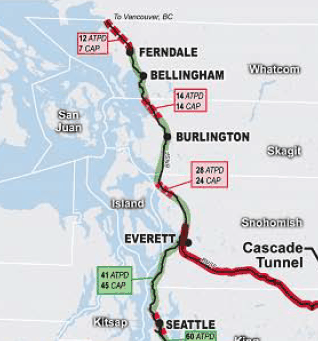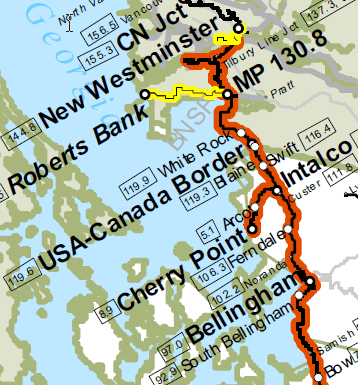Washington’s rail system is congested in places. Adding dozens of coal trains each day, without also big new capacity improvements, could cripple the system with gridlock. All that is common knowledge. Less well-known is this: coal shipments are already causing problems.
To understand what’s going on, it’s useful to zero in on the northwest portion of the state’s railway system. Here’s a close look at northwest Washington, the area most directly affected by Cherry Point coal exports:
This Cambridge Systematics map from 2006 is the most recent comprehensive analysis of the state’s rail system. The green on the mainline between Everett and Canada indicates adequate capacity, but the numerous red dots indicate hotspots of local congestion that plague the system.
What’s happening on the ground there now? In May 2011, the regional rail experts at the Cascadia Center produced the “Cross-Border Freight Rail Improvement Study,” for the Whatcom Council of Governments (along with a companion volume “Cross-Border Passenger Rail Improvement Study). It turns out that things in the area are not going smoothly.
There are a variety of reasons, but one reason is coal.
To understand why, it’s helpful to understand the basic configuration of the rail system. Here’s a fragment of BNSF’s regional map, showing more local detail:
The mainline track extends north-south between New Westminster, BC and Bellingham. Jutting off to the west from the mainline are two branch lines, one north of the border and one south. The Canadian side’s branch line (in yellow) runs to the Westshore coal terminal at Roberts Bank; the American side has a branch line, called the Custer Intalco line, (in orange) to Cherry Point.
Coal shipments on the Canadian branch line to Westshore are already clogging the system, and for a considerable distance. In fact, the Cascadia report notes that:
Increased congestion on the east-west Roberts Bank rail corridor that BNSF uses to deliver coal to the Westshore Coal Terminal are causing the railroad to hold trains south of Bellingham.
In other words, coal trains clogging the branch line are sending ripples of congestion well down the mainline. And the same scenario will play out south of the border if coal exports began to move from Cherry Point, as the Cascadia study points out:
Future cross border shipments of coal and other commodities by BNSF may be greatly influenced by a new facility near the border proposed by SSA Marine… The entrance to the [branch line] has the potential to create an operational bottleneck if the train frequencies expected by the Terminal materialize. Industry switch engines, slowly moving loaded coal trains and the resulting empties could result in volumes of traffic that would tax the mainline and small yard that is located at Custer. With the close proximity of the border to the Custer Intalco line, future congestion may result.
“Future congestion may result” is a good candidate for the understatement of the year. To understand why, let’s do the numbers.
According to Cascadia, BNSF runs an average of 15 trains per day from the Seattle-Everett area up to Vancouver, BC plus 2 Amtrak passenger runs. Yet according to the terminal proponents, the terminal would put up to 18 roundtrip trains on the system. In other words, trains serving Cherry Point would more than double the existing rail traffic in that area. That’s before the region sees any other freight expansions, and before the region gets new passenger rail service.
Now take a closer look at the first map up above. (If it’s not clear, click to enlarge it or see page 29 of this pdf.) The red boxes display the number of trains per day (top number) and the actual practical capacity (bottom number). Between Burlington and the Canadian border there are places where the system’s practical capacity is 14, or even just 7, trains per day. In these places, of course, the system is already congested. Adding 18 trains per day doesn’t seem possible.
Here’s the point: even if we removed every single freight and passenger train—and we did nothing but serve Cherry Point—those shipments alone would swamp the northern portion of the state’s rail system.
To be sure, rail congestion is a fixable problem, at least to an extent. There are a number of infrastructure and technology improvements that would boost capacity in the system. The catch, however, is that these improvements tend to be costly, and the majority of them are likely to get billed to the public. In fact, as we’ll explore in some follow-up posts, there is good reason to worry that taxpayers—not BNSF and not the coal companies—will be asked to expand the state’s railway system to make way for coal.
In the meantime, the biggest loser may be the region’s long-sought high speed rail service. Unless taxpayers are prepared to open their wallets again, it could well turn out that reliable passenger rail in the Northwest will run into the brick wall of Asia-bound coal.
But more on that later.
This post would not have been written without valuable research assistance from Dave Kershner.




Comments are closed.